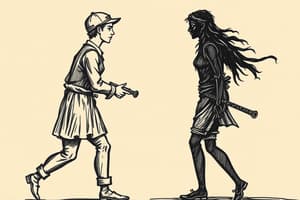Podcast
Questions and Answers
Conflict is defined as the cooperation of actions, ideas, and desires of the characters.
Conflict is defined as the cooperation of actions, ideas, and desires of the characters.
False (B)
An internal conflict is localized in the external world of the character.
An internal conflict is localized in the external world of the character.
False (B)
In a 'man against himself' conflict, the character is in conflict with his own qualities of character.
In a 'man against himself' conflict, the character is in conflict with his own qualities of character.
True (A)
The protagonist is always a sympathetic character in the story.
The protagonist is always a sympathetic character in the story.
Aesthetic conflicts involve physical struggles between characters.
Aesthetic conflicts involve physical struggles between characters.
A single conflict that begins, develops, and ends within the boundaries of the story is known as a global conflict.
A single conflict that begins, develops, and ends within the boundaries of the story is known as a global conflict.
Conflict in a story is usually simple when there is only a single conflict.
Conflict in a story is usually simple when there is only a single conflict.
In the stories mentioned, conflicts are never reflected against a historical background.
In the stories mentioned, conflicts are never reflected against a historical background.
Characters in the stories always face only one conflict at a time.
Characters in the stories always face only one conflict at a time.
Setting elements are never explicitly pointed out in a story.
Setting elements are never explicitly pointed out in a story.
Implicit setting details may include descriptions of landscape and cultural monuments.
Implicit setting details may include descriptions of landscape and cultural monuments.
The setting of a story includes the physical background, place, and time of the story.
The setting of a story includes the physical background, place, and time of the story.
Flashcards are hidden until you start studying
Study Notes
Conflict in Literature
- In stories with a single conflict, the plot is usually simple.
- In more complex stories, the conflict is often set against a historical background, involving social problems, historical events, and moral values.
- Characters in these stories are involved in multiple conflicts, with their fate and problems developed as private conflicts against a larger background.
Setting in Literature
- The setting of a story includes the physical background, time, and place of the action, as well as significant items surrounding the characters.
- The setting can be described explicitly with specific dates or place names, or implicitly with descriptive details.
- Examples of implicit setting details include descriptions of landscape, weather, colors, sounds, traditions, or cultural monuments.
Examples of Setting
- In the example from J.D. Salinger, the setting is explicitly stated as New York, and the time period is implicitly suggested to be the 20th century through the use of language and cultural references.
- In the example from M. Spark, the setting is implicitly suggested to be an English school, with the use of specific terms like "Secondary Modern School" and "Grammar School".
Conflict Types
- Conflict is defined as the clash of actions, ideas, and desires of the characters.
- There are three types of conflicts: man against man, man against environment, and man against himself.
- Man against man conflicts involve a character vs. another person or group, man against environment conflicts involve a character vs. nature or society, and man against himself conflicts involve a character's internal struggles.
External and Internal Conflict
- The first two types of conflict (man against man and man against environment) are external conflicts, while the third type (man against himself) is an internal conflict.
- Internal conflicts are localized in the character's inner world and are expressed through their thoughts and feelings.
Plot Conflict
- A story's plot can include both internal and external conflicts.
- Conflicts can be aesthetic, ethical, physical, mental, emotional, or moral.
- The central character in a conflict is referred to as the protagonist, and the opposing character is referred to as the antagonist or foil.
Types of Plots
- In some stories, the conflict is single, clear-cut, and easily identified (e.g. O. Henry stories).
- A single (or local) conflict begins, develops, and ends within the boundaries of the story.
Studying That Suits You
Use AI to generate personalized quizzes and flashcards to suit your learning preferences.




